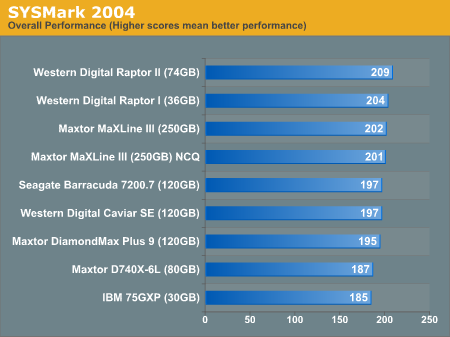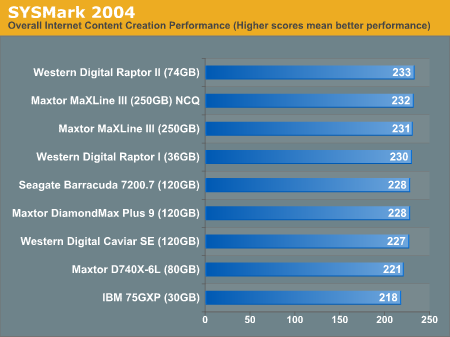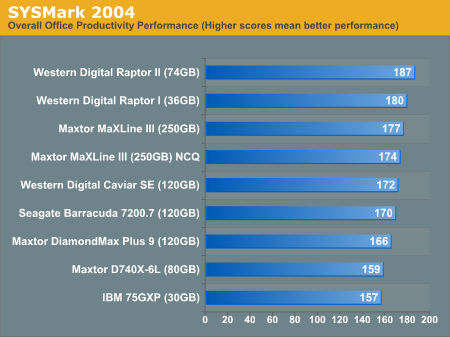Maxtor's MaXLine III 250GB: Bringing 16MB Buffers and NCQ to Hard Drives
by Anand Lal Shimpi on June 25, 2004 12:03 AM EST- Posted in
- Storage
SYSMark Performance Summary
The overall SYSMark scores summarize what we've seen thus far:
The overall graph echoes our earlier comments - the 16MB buffer manages to give the MaXLine III performance that rivals the Western Digital Raptors, but while offering much larger capacities.
As a recap, here's what happens with the Internet Content Creation suite:
"In this scenario, the content creator creates a product-related website targeting a broadband and narrowband audience. The user first renders a 3D model to a bitmap, while preparing web pages using a web site publishing tool. The user opens a video editing package, creates a movie from several raw input movie cuts and sound cuts and starts exporting it. While waiting on this operation, the user imports the rendered image into an image-processing package, modifies it and saves the results. Back in the 3D modeling software, the user modifies a 3D model and exports it to a vector-graphics format. Once the movie is assembled, the user edits it and creates special effects using one of the modified images as input. The user extracts content from an archive. Meanwhile, he uses an animation creation tool to open the exported 3D vector graphics file. He modifies it by including other pictures and optimizes it for faster animation. The final movie with the special effects is then compressed in a format that can be broadcast over broadband Internet. The web site is given the final touches and the system is scanned for viruses."

Once again, we see that in internet content creation tests, the MaXLine III comes within striking distance of the Raptor, thanks to its 16MB buffer.
Also recapping, here's what happens in the entire Office Productivity suite:
"In this scenario, the office productivity user creates a marketing presentation and supporting documents for a new product. The user receives email containing a collection of documents in a compressed file. The user reviews his email and updates his calendar while a virus checking software scans the system. The corporate web site is viewed and the user begins creating the collateral documents. The user also accesses a database and runs some queries. A collection of documents are compressed. The queries' results are imported into a spreadsheet and used to generate graphical charts. The user then transcribes a document. Once the document has all the necessary pieces in place, the user changes it into a portable format for easy and secure distribution. The user edits and adds elements to a slide show template. Finally, the user looks at the results of his work (both the slide show and the portable document) in an Internet browser."

And we conclude our look at SYSMark with more confirmation to our conclusions.










38 Comments
View All Comments
broberts - Friday, June 25, 2004 - link
While the the article stresses that the tests attempt to duplicate real world conditions I noticed that, at least for the one benchmark, the o/s is on a separate drive. IMO most "real world" systems contain one drive, or at least one logical drive (RAID). Having the o/s and swap file on the same drive would, I suspect (and even with 1GB of RAM which is a little over the top), tend to highlight the difference between NCQ and TCQ performance.NCQ should only make a real difference when disk head movement is the bottleneck. A test such as loading a big program isn't going to really test anything unless the program is fragmented or some o/s activity (like swapping) concurrently takes place on the drive.
I also wonder how much of the advantages of NCQ are negated by the bigger cache? 16MB in a desktop environment is significant. It may well account for the closeness of the numbers reported.
Anand Lal Shimpi - Friday, June 25, 2004 - link
Thanks for the responses guys, we're committed to making our storage coverage top notch on par with the articles in our other sections so it's going to take lots of constructive criticism to make sure we're providing that; keep it coming.You've already noticed that there were no sound/heat tests in the article. We got great response from the MP3s I posted of the drives in our first HDD roundup under the new suite, but we're still lacking a good quantitative way of comparing the sound levels of these hard drives. In the worst case scenario I could always just use a trusty SPL meter, but I want to do something a little more useful. Give me another week or so and I'll see if I can't at least have a prototype of what I'm trying to do.
In terms of our excitement about NCQ, the conclusion never stated that NCQ increased performance tremendously across the board. But also remember that we only had three heavy-multitasking benchmarks, and the performance boost we saw in one of them (a very common scenario, who doesn't copy a file and browse the net or check email?) was nothing short of outstanding. NCQ is sort of like Hyper Threading in the sense that it doesn't improve performance by 20% across the board, but in a few very real world scenarios, the performance boost is nothing short of impressive. And as workloads become more parallelized in nature, we'll continue to see bigger benefits from NCQ. For current sequential desktop applications, NCQ doesn't do anything at all; but remember that AMD and Intel are both going down the multicore CPU route for a reason - desktop usage patterns are changing. We're very excited about NCQ as a technology because it anticipates that changing environment and definitely improves performance in it.
Will you see a performance boost from NCQ today? If you're a heavy multitasker at all, then yes. Otherwise, no. Just ask yourself, how many times have you copied a file while doing other things in the background. A 10% performance gain in that one test is much more than any other real world hard drive performance improvement we've seen in recent history.
Take care,
Anand
Operandi - Friday, June 25, 2004 - link
I thought it was a pretty good article. I don't know where your people are coming from saying sounds like Maxtor PR paper. It may not be as fast as the raptor but then again it's a 250-300 gig drive not 74, fair trade if you ask me.As far as noise goes it should be identical to Diamond Max series. There is no reason for it to be any louder, aside from the 16 meg buffer and NCQ the drive is most likely identical mechanically.
GhandiInstinct - Friday, June 25, 2004 - link
So, I am also curious, how loud is it? How much will it cost?MaxLine or Raptor?
Seems to me, as a gamer, Raptor won in all the gaming related benchmarks.
Pariah - Friday, June 25, 2004 - link
I agree with #11. I got the same impression aftering reading the conclusion which didn't seem to take any of the rest of the article into account. The conclusion seemed to be based in wishful thinking of what he had wanted to see, rather than being based on the numbers his article actually produced, which were not nearly as positive.The Raptor does not support NCQ. It supports the old ATA TCQ which is inferior in its implementation. However, looking at the lackluster performance of NCQ, it's not hard to believe the even worse #'s that StorageReview just posted on the Raptor's TCQ performance in workstation benchmarks.
Also, the 7200.7's do not support NCQ either. Seagate announced a new version of the 7200.7 that will, but has not reached the market yet.
Jeff7181 - Friday, June 25, 2004 - link
What would make it any louder than Maxtor's other 7200 RPM drives? I doubt they'd go back to using ball bearings and noisy servo's just to give us NCQ.T8000 - Friday, June 25, 2004 - link
It would indeed be interesting to see how other drives that support NCQ, like the Seagate and the Raptor 74 GB would benefit from it.Altough, I am not sure if the Raptor has NCQ or TCQ, but that could make it even more interesting, as NCQ and TCQ could be compared.
QuaiBoy - Friday, June 25, 2004 - link
This article reads like Maxtor promotional copy, giving the Maxtor high praise in tests where it fails to even outpace it's 7200RPM competition. Also, like #9 said, how loud is it? Vibration? Heat? Interesting omissions to the article... bet it sounds like a jet turbine given my past experiences with Maxtor.bwall04 - Friday, June 25, 2004 - link
I'm not sure why this was overlooked but the 74GB Raptor supports NCQ. I think it would paint a clearer picture of the performance of NCQ and situations where it is beneficial if the review could be edited to add in these results.Kudos to Maxtor for stepping up with something to compete with my Raptors, and with 3x the storage!!
jcromano - Friday, June 25, 2004 - link
How loud is it?